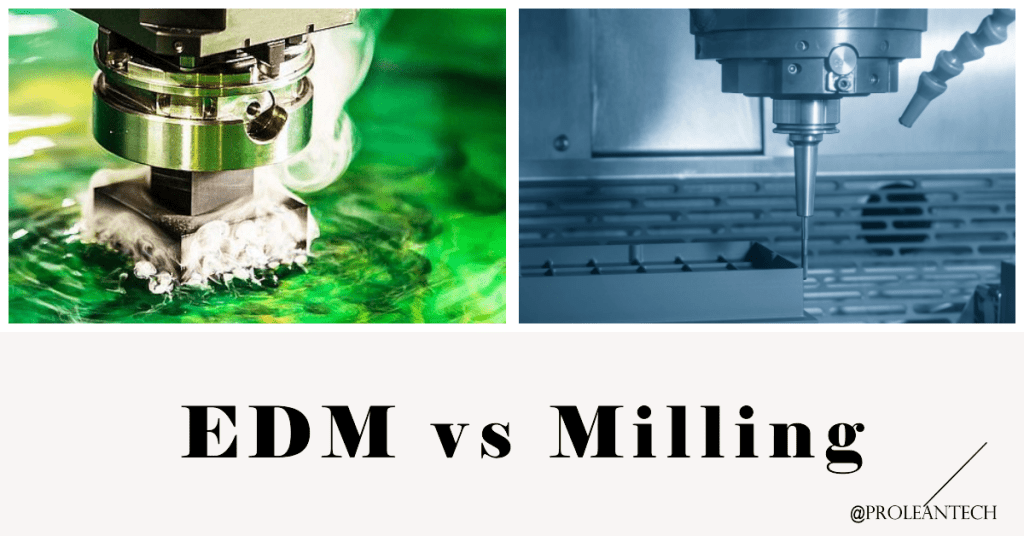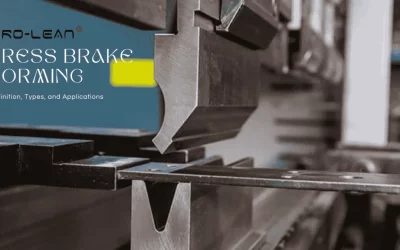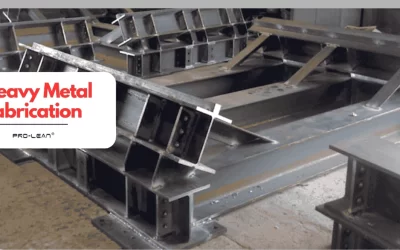
In the manufacturing industry, selecting the right method for shaping and producing parts is a crucial decision. In this comprehensive comparative study, we will uncover the key differences between Electrical Discharge Machining (EDM) and Computer Numerical Control (CNC) milling.
This article aims to equip you with the knowledge to make the right choice for your project by exploring processes, advantages, disadvantages, industries, and future trends.
Introduction to EDM and Milling
Before diving into the key differences between EDM and milling, it’s essential to understand what these processes are and how they work. Both EDM and CNC milling are distinct manufacturing methods that use different principles and techniques to shape materials.
1. Understanding Electrical Discharge Machining (EDM)
Electrical Discharge Machining, commonly known as EDM, is a non-traditional manufacturing process that uses electrical discharges to remove material from a workpiece. This method involves placing an electrode in close proximity to a conductive workpiece submerged in a dielectric fluid, such as water or oil. A series of electrical discharges occur between the electrode and the workpiece, eroding the material from the workpiece.
There are two main types of EDM: wire-cut EDM and die-sinking EDM. Wire-cut EDM, also known as wire electrical discharge machining or wire EDM, uses a thin wire as the electrode, while die-sinking EDM, also known as ram EDM or sinker EDM, uses a shaped electrode. Both types have their unique applications and are suitable for different scenarios.
2. The Process of CNC Milling
CNC milling is a widely used subtractive manufacturing process that uses computer-controlled machines to shape and remove material from a workpiece. The process involves a rotating cutting tool, known as a mill, that moves along multiple axes to remove material and achieve the desired shape.
CNC milling machines can be programmed to produce complex parts with high precision and accuracy, making them ideal for a wide range of industries and applications. The versatility of CNC milling allows manufacturers to work with a variety of materials, including metals, plastics, and composites.
Related to:
- A Look at the Precision and Accuracy of EDM
- Exploring the Key Differences Between Wire and Sinker EDM Techniques
Key Differences between EDM and CNC Milling
When comparing EDM vs milling, there are several key differences that set these two manufacturing methods apart. These differences are essential to consider when selecting the appropriate process for your project.
1. Material Removal Mechanisms
One of the most significant differences between EDM and CNC milling is the way the material is removed from the workpiece. In EDM, material removal occurs through electrical discharges, which erode the workpiece material. This process does not involve any mechanical force, allowing for the machining of fragile and delicate materials.
On the other hand, CNC milling relies on the mechanical force of a rotating cutting tool to remove material. This method is more suitable for materials that can withstand the stress of the cutting process.
2. Surface Finish and Accuracy
EDM is known for its ability to achieve high levels of accuracy and surface finish. The process can create intricate shapes and small features that would be challenging to achieve with conventional milling methods. Additionally, the absence of mechanical force in the EDM process reduces the risk of deformation and damage to the workpiece.
CNC milling, while capable of producing accurate parts, may struggle with extremely small features and tight tolerances. Additionally, the mechanical force of the cutting tool may cause burrs and other surface imperfections, which may require additional post-processing.
3. Material Compatibility
EDM is limited to conductive materials, as the process relies on electrical discharges for material removal. This means that materials such as metals and some conductive ceramics are suitable for EDM, while non-conductive materials like plastics and non-conductive ceramics cannot be machined using this method.
CNC milling, on the other hand, is compatible with a broader range of materials, including metals, plastics, and composites. This versatility allows CNC milling to be used in a wider variety of applications and industries.
Advantages and Disadvantages of EDM
Like any manufacturing process, EDM has its advantages and disadvantages. Understanding these factors can help you determine if EDM is the right choice for your project.
Table: Advantages and disadvantages of EDM
| Advantages of EDM | Disadvantages of EDM |
|---|---|
| High precision and surface finish: EDM is capable of achieving tight tolerances and intricate shapes that may be difficult or impossible with conventional milling methods. | Limited material compatibility: EDM can only be used on conductive materials, limiting its applicability in certain industries and applications. |
| No mechanical force: The absence of mechanical force in the EDM process reduces the risk of deformation and damage to the workpiece, making it ideal for fragile and delicate materials. | Slow material removal rate: The EDM process is typically slower than CNC milling, which can affect production times and costs. |
| Suitable for hard materials: EDM can machine materials that are difficult to cut using conventional milling methods, such as hardened steels and super-alloys. | Consumable electrodes: In die-sinking EDM, the shaped electrode is consumable, meaning it will wear over time and require replacement, adding to the cost of the process. |
Advantages and Disadvantages of CNC Milling
Similar to EDM, CNC milling also has its own set of advantages and disadvantages that should be considered before selecting the manufacturing method for your project.
| Advantages of CNC Milling | Disadvantages of CNC Milling |
|---|---|
| CNC milling can work with a wide range of materials, including metals, plastics, and composites, making it versatile for different industries and applications. | CNC milling can produce surface imperfections, such as burrs and rough edges, that may require additional post-processing. |
| CNC milling machines are capable of producing parts with high precision and accuracy, making them ideal for tight tolerances and intricate shapes. | CNC milling may struggle with materials that are too hard or brittle, such as hardened steels and ceramics. |
| CNC milling is typically faster than EDM, allowing for higher production rates and lower costs. | CNC milling may not be suitable for complex shapes and features that require multiple axes or intricate tool paths. |
| CNC milling machines use solid cutting tools that are less prone to wear and tear than the consumable electrodes used in EDM. | CNC milling machines can be expensive to purchase and maintain, making them less accessible for small-scale production. |
Try Prolean Now!
EDM vs CNC Milling: Choosing the Right Method for Your Project
When selecting between EDM vs milling, there are several factors to consider, including material compatibility, surface finish, accuracy, and production time. The decision ultimately depends on the specific requirements of your project, such as the desired shape, tolerances, and material properties.
For example, if you require high precision and surface finish in a conductive material, EDM may be the better choice. On the other hand, if you need to machine a variety of materials with complex geometries, CNC milling may be more suitable.
ProleanTech provides both CNC machining and EDM services based on your project specifications and needs. Contact us today to discuss your project and determine the best manufacturing method for your needs.
Differences: Industries and Applications of EDM and CNC Milling
EDM and CNC milling are used in a variety of industries and applications, each with its unique requirements and challenges. Understanding these differences can help you determine which method is appropriate for your project.
Industries and Applications of EDM
- Aerospace: EDM is commonly used in the aerospace industry to machine turbine blades, engine components, and other critical parts that require high precision and accuracy.
- Medical: EDM is used in the medical industry to manufacture implants, surgical tools, and other medical devices that require complex geometries and biocompatibility.
- Tool and die: EDM is frequently used in the tool and die industry to create molds, dies, and other tooling components that require intricate shapes and tight tolerances.
- Electronics: EDM is used in the electronics industry to produce micro-components, such as connectors and sensors, that require high precision and accuracy.
Read more: EDM (Electrical Discharge Machining) in Medical Device Manufacturing
Industries and Applications of CNC Milling
- Automotive: CNC milling is commonly used in the automotive industry to manufacture engine components, transmission parts, and other critical components that require high strength and durability.
- Consumer goods: CNC milling is used in the consumer goods industry to produce a variety of products, such as electronic enclosures, phone cases, and other plastic or metal parts.
- Energy: CNC milling is used in the energy industry to manufacture wind turbine components, oil and gas drilling equipment, and other parts that require high precision and strength.
- Prototyping: CNC milling is frequently used in prototyping to produce parts quickly and accurately for testing and evaluation.
Future Trends in EDM and CNC Milling Technologies
As technology continues to evolve, EDM and CNC milling are also advancing to meet the demands of the manufacturing industry. Some of the future trends in EDM and CNC milling technologies include:
| Future of EDM | Future of CNC Milling |
|---|---|
| EDM is being combined with 3D printing to create hybrid manufacturing processes that can produce complex geometries and parts with unique material properties. | CNC milling is being combined with other manufacturing processes, such as laser cutting and additive manufacturing, to create hybrid processes that can produce complex and unique parts. |
| EDM machines are incorporating advanced controls and software that can automate the machining process and improve accuracy and efficiency. | CNC milling machines are incorporating automation and robotics to improve efficiency and reduce the need for human intervention. |
| Research is being conducted to develop EDM processes that can machine non-conductive materials, such as ceramics and plastics. | CNC milling is being used to machine advanced materials, such as composites and high-temperature alloys, that require specialized tooling and machining techniques. |
Read more: The Science and Technology Behind EDM
Conclusion: Making the Right Choice between EDM and CNC Milling
In conclusion, selecting the right manufacturing method between EDM and milling depends on several factors, including material compatibility, surface finish, accuracy, and production time. Each method has its unique advantages and disadvantages, making it essential to consider the specific requirements of your project before making a decision.
At ProleanTech, we offer both CNC milling service and EDM services based on your project specifications and needs. Contact us today to discuss your project and determine the best manufacturing method for your needs.
FAQ’s
What materials can be machined using EDM?
EDM can machine conductive materials, such as metals and some conductive ceramics.
What materials can be machined using CNC milling?
CNC milling can work with a wide range of materials, including metals, plastics, and composites.
Which method is more suitable for high precision and surface finish?
EDM is known for its ability to achieve high precision and surface finish.
Which method is faster?
CNC milling is typically faster than EDM.
What industries use EDM?
EDM is commonly used in the aerospace, medical, tool and die, and electronics industries.
What industries use CNC milling?
CNC milling is commonly used in the automotive, consumer goods, energy, and prototyping industries.




0 Comments